How to Call Uk From Philippines Using Globe
All passengers traveling to or connecting in the United Kingdom need to present a negative coronavirus test result and complete a passenger locator form. Yes, this applies even if you're just transiting airside while traveling between two other countries.
In this post I wanted to outline my experience with this pre-travel testing requirement, as well as the passenger locator form, based on my transit at London Heathrow Airport while traveling between the United States and Greece earlier this summer. I initially published this back in May, but wanted to update the post to reflect the current situation, and to also address the most frequent questions I've received regarding the process since this post was first published.
Let me emphasize that you should always check official government websites for guidance — the below outlines my experience, which might not match your experience, especially with regulations constantly changing.
England's travel coronavirus testing requirement
All air travelers to England need to provide proof of a negative coronavirus test. This applies even if you've been vaccinated, if you're traveling from a green list country, if you're a citizen, etc.
Note that requirements are slightly different for Wales, Scotland, and Northern Ireland, so I'll be focused on England here, since that's where most of the major points of entry are, and that's what my firsthand experience was with (meanwhile the passenger locator form is for the entire United Kingdom).
When do you need to get tested?
Your coronavirus test needs to be taken within three days of the departure of your nonstop flight to the United Kingdom. In other words, if you fly from New York to London and depart on a Thursday and arrive on a Friday, you could get tested as early as Monday (and this is based on calendar days, and not a strict 72 hour interpretation).
What kind of testing qualifies?
The good news is that you're not limited to a PCR test, but rather a rapid antigen test generally qualifies as well, as long as the test meets performance standards of ≥97% specificity and ≥80% sensitivity at viral loads above 100,000 copies/ml.
This could include tests such as:
- A nucleic acid test, including a polymerase chain reaction (PCR) test or derivative technologies, including loop-mediated isothermal amplification (LAMP) tests
- An antigen test, such as a test from a lateral flow device
What information does the test need to have?
The test must include the following:
- Your name, which should match the name on your travel documents
- Your date of birth or age
- The result of the test
- The date the test sample was collected or received by the test provider
- The name of the test provider and their contact details
- Confirmation of the device used for the test, or that the test was a PCR test
The UK's passenger locator form
Anyone traveling to or through the United Kingdom needs to complete a passenger locator form each time they take a trip:
- For people staying in the UK, this form asks details about where you plan on staying, given the mandatory quarantine for many travelers
- All passengers (including transit passengers) need to provide exact details about their flights and even where they're seated, presumably (at least to some extent) for contact tracing purposes
We just had a layover at London Heathrow Airport where we were staying airside, so I'll share the process of completing this requirement for us. Note that each adult has to complete their own form.
So, how does the process work? There are three main steps, which I'll outline below:
- First you can create a passenger locator form account, which will save your basic details for six months from your previous activity; you might as well create an account, since you have to enter this info anyway, and this means you won't have to enter basic details again when traveling through the UK in the future
- Next you have to enter details about your specific trip
- Lastly you have to print out your form and bring it with you to an airport; some airlines have services that they use to simplify the process so that you can upload this in advance and be "verified" before you get to the airport, so look out for those (for example, American and British Airways use VeriFLY)
When should you complete the passenger locator form?
You can complete your UK passenger locator form up to 48 hours before arriving in the United Kingdom. Personally I think completing the form 24-48 hours before arriving in the UK is the sweet spot:
- You can't do so more than 48 hours before arrival, presumably because travel plans can frequently change further out than that, and you have to provide very specific details, down to your seats
- This is far enough from departure so that you can still upload all of your details to a third party service like VeriFLY and have time for that information to be verified, which will expedite your check-in process
Plan on it taking around 15 minutes per passenger to complete the passenger locator form, not including the VeriFLY process, should you choose to use it.
Step #1: Create a passenger locator form account
To create a passenger locator form account you'll need to provide some basic details about yourself, including your name, contact details, passport details, and address.
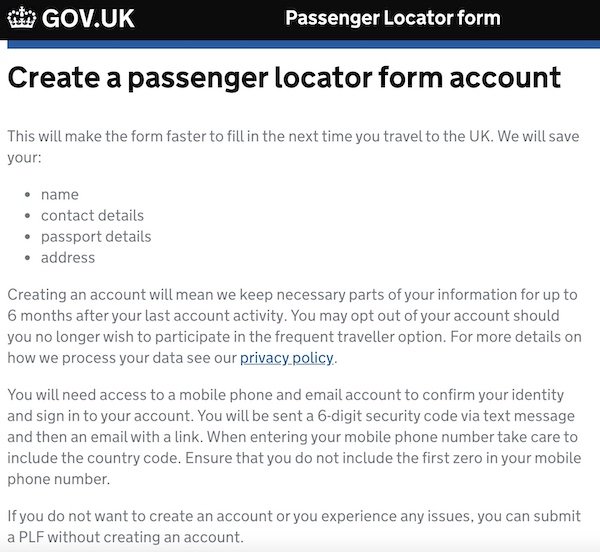
To create an account, you need to provide an email, phone number, and password.
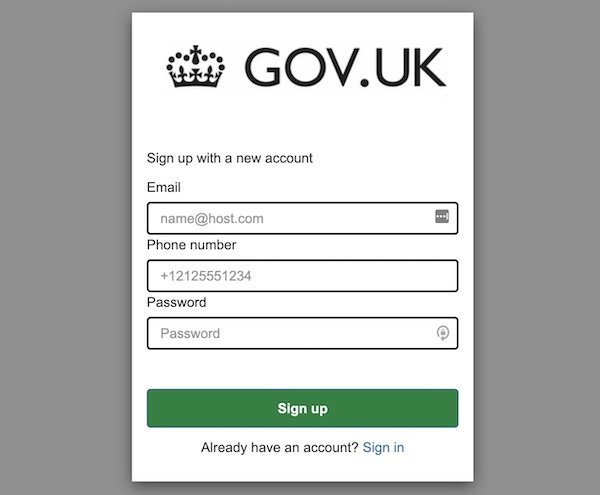
Below you can see the questions you'll be asked, starting with your name, sex, date of birth, telephone number, how you can be contacted, your home address, and your passport details.

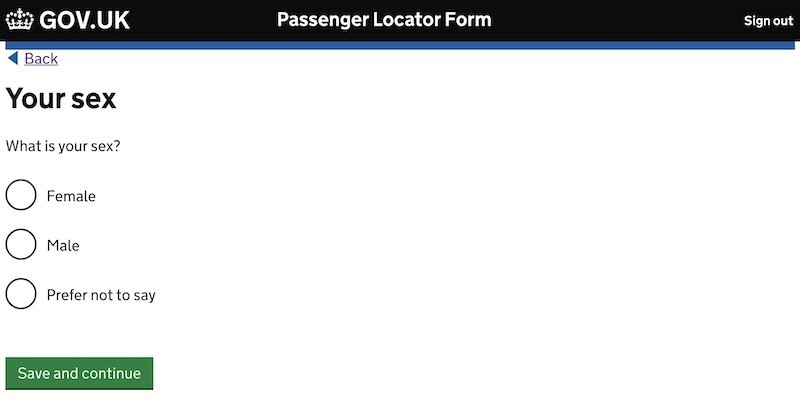

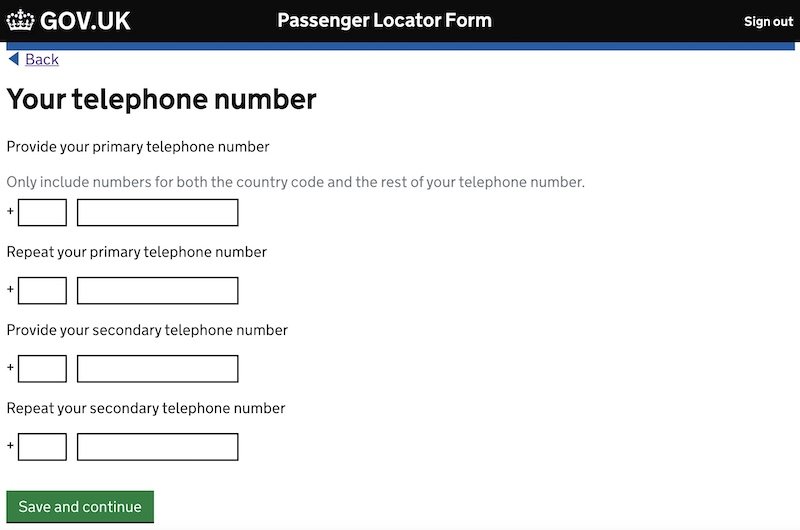
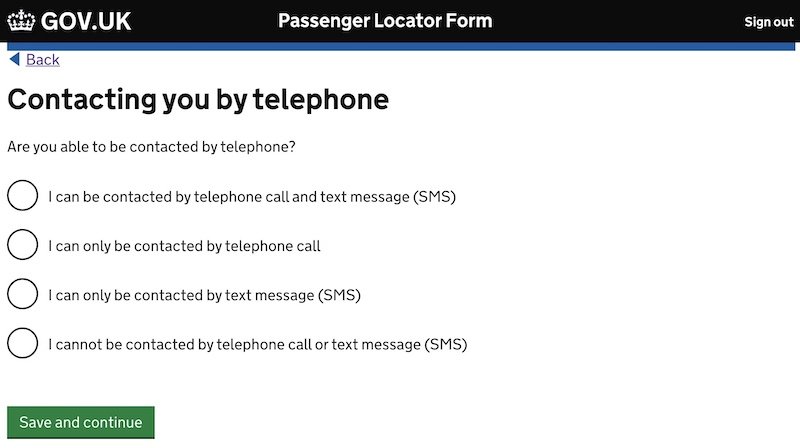
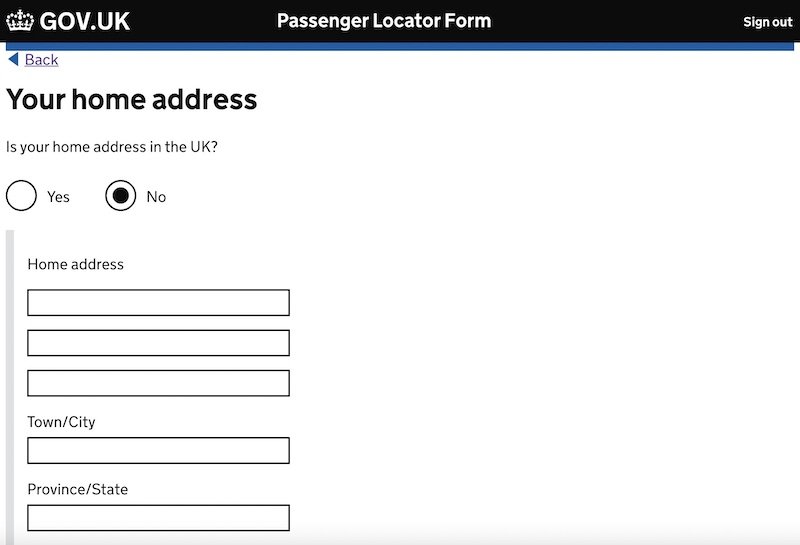
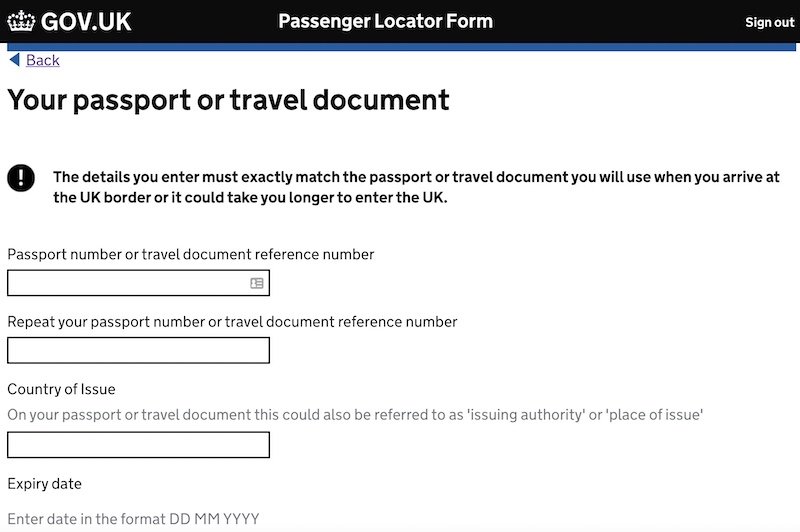
Step #2: Upload your trip details
Once you've created a passenger locator form account, you'll be able to upload specific details about your trip. While you'll only need to create an account once, you will need to upload trip details with each trip. When logged in you can click the "Create a new form" button, and then you can enter your trip details.
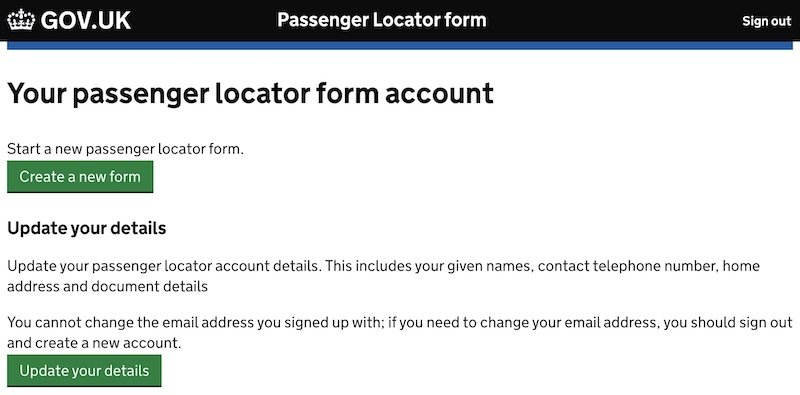
You'll be asked to share when you plan to arrive in the UK, and when you plan to depart.
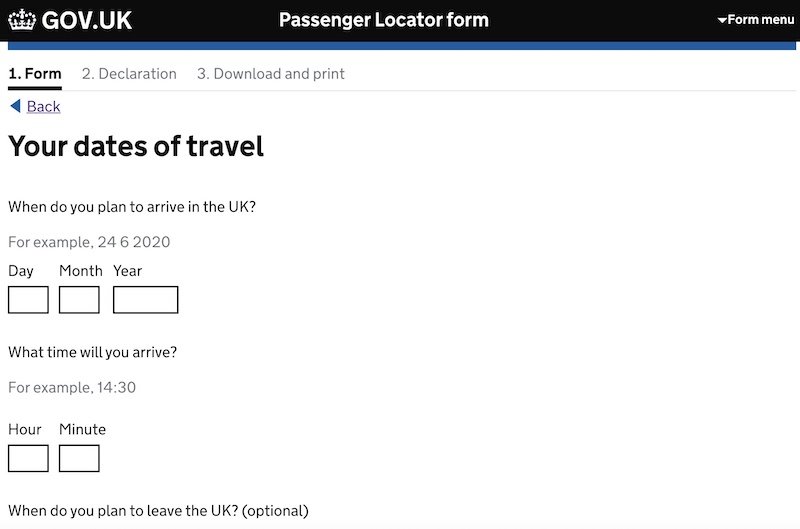
You'll then be asked about your vaccination status. That's because as of recently, fully vaccinated travelers coming from amber list countries no longer need to quarantine. So you'll be asked to confirm that you've been fully vaccinated at least 14 days prior to arriving in the UK, and that you haven't been in any red list countries in the past 10 days.
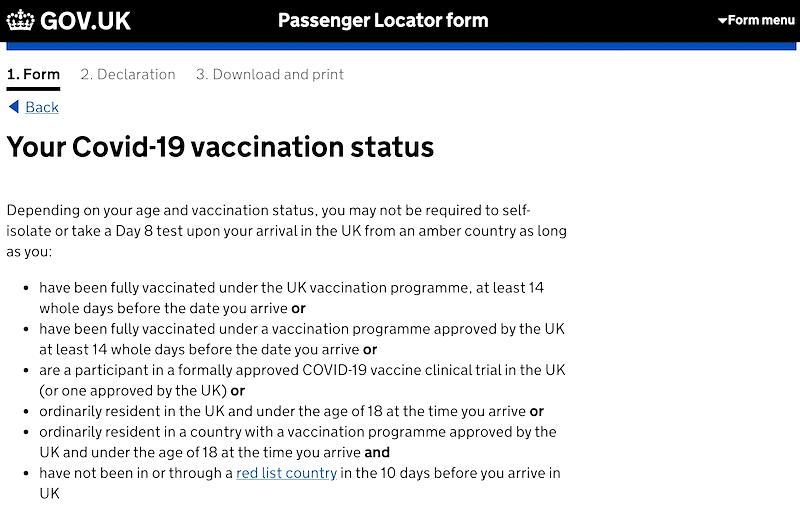
Assuming you've been vaccinated, you'll then be asked in what country your vaccination took place.

You'll then be asked if you plan to stay in the UK or are just in transit.

You'll be asked what airport you'll be arriving at, what country you're traveling from, which flight you're taking, and what your seat number is (if you haven't yet been assigned a seat, I'd recommend just writing "none," as that does the trick, and allows you to proceed).
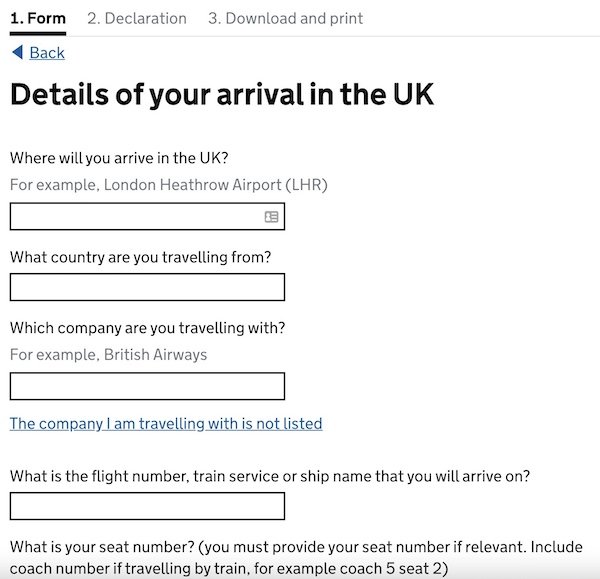
You'll be asked what airport you'll be departing from, what country you're traveling to, which flight you're taking, and what your seat number is.
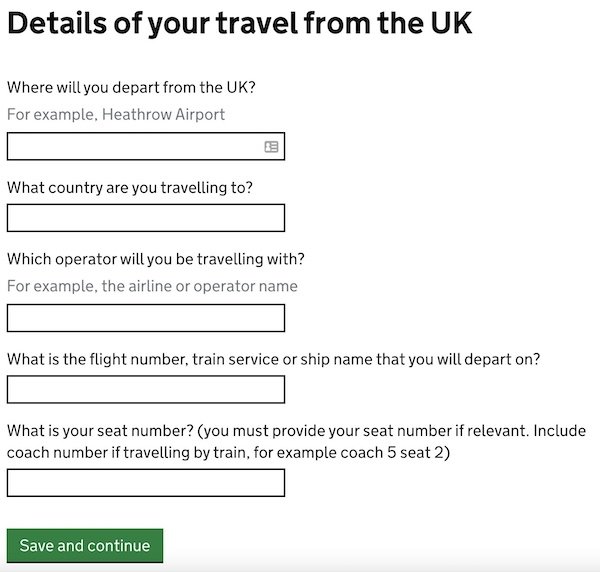
You'll then be asked if you're traveling with any minors, since they can be added to the same form (while adult travel companions can't be).
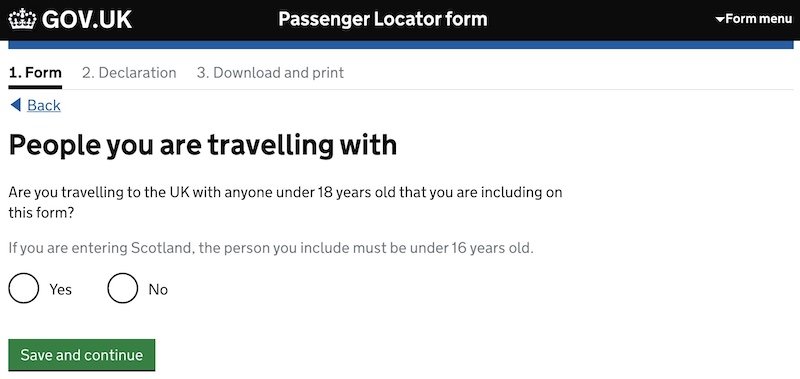
If you're entering the United Kingdom, you'll also be asked if you're required to book a coronavirus test for the second day you're in the country. Day two testing is required if you're coming from an amber list country and are skipping quarantine on account of being vaccinated (if you're spending under two days in the UK, then there's no need to get a day two test).
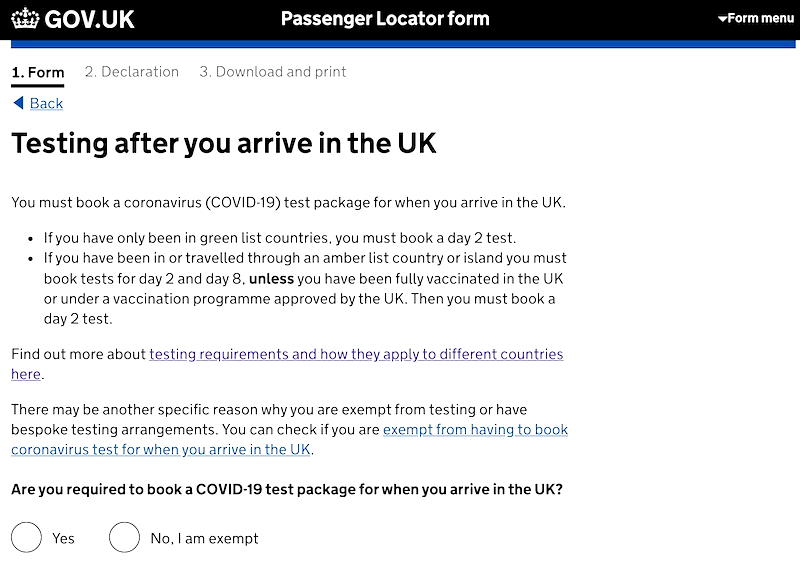
If you answer yes, you'll need to provide your test booking reference. You can only get tested through an official provider (here's the list of eligible providers), and once you book a test, you'll be given a test booking reference, which you'll have to enter.
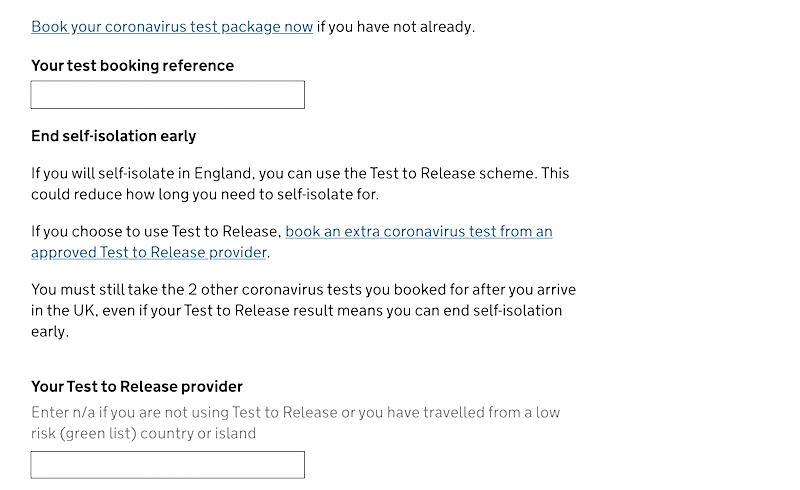
Lastly, you'll be asked to confirm that all the information you shared is correct, and that you understand you'll need to provide proof of a negative coronavirus test.
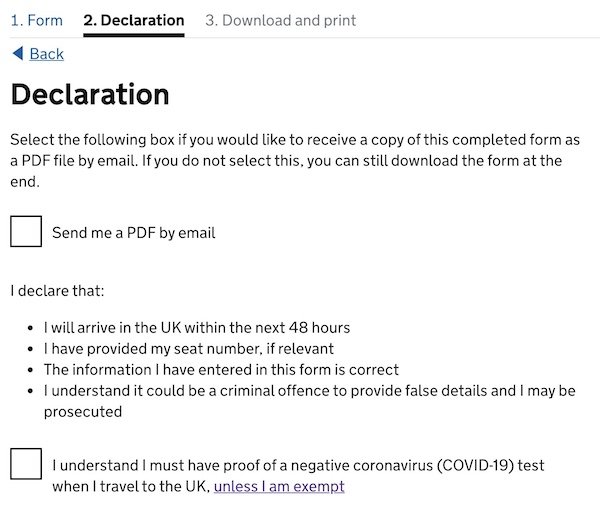
At that point your form will be submitted, and you'll be able to download your passenger locator form, which will also be emailed to you. This will contain a reference number.
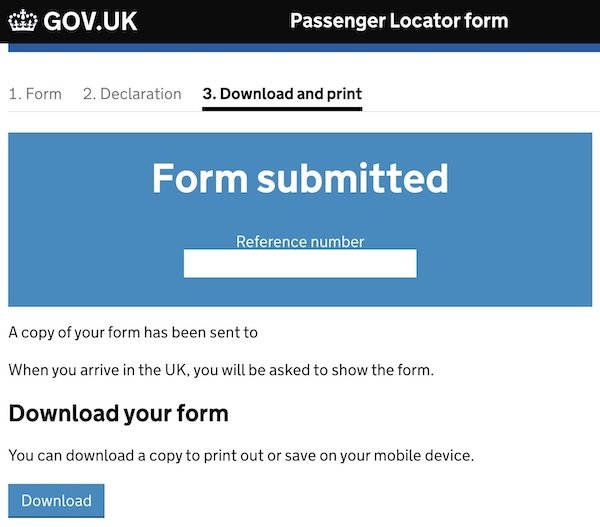
Step #3: Have your passenger locator form on hand (and more)
In theory at this point you're all set, and you could just show up at the airport for check-in with your form.
However, some airlines have partnered with services that allow you to upload this information in advance and have it verified before you even get to the airport, intended to cut down on the amount of time it takes to check-in. Think of it like TSA Pre-Check for your travel documents.
For example, American and British Airways (the biggest airline joint venture in the UK) use VeriFLY to allow passengers to upload their passenger locator form and negative coronavirus test result prior to travel.
I'll outline the process of using VeriFLY in a separate post, as it's super clunky and not great, but I'd consider it to be a necessary evil.
Prior to my trip, I wondered if this was even necessary or useful. While not necessary, it would appear that it is useful. When I checked in at the American Airlines counter prior to my trip and informed the agent I had completed the VeriFLY process, he said "oh my God, I love you, thank you."
I was surprised by the response, so I asked if VeriFLY actually made things that much easier, to which he responded "it's like an extra 45 minutes, you don't understand how many steps they make us go through."
Even with having completed VeriFLY, check-in took about 20 minutes.
Note that it was only at check-in that this was needed — as transit passengers we weren't at any point in the UK asked to show our passenger locator form or negative coronavirus test result.
Bottom line
If you're traveling to the UK (including just transiting an airport) you'll need to complete a passenger locator form within 48 hours of arrival, and provide proof of a negative coronavirus test within three days of travel. Hopefully the above is a useful breakdown of my experience.
Expect the process of filling out the actual form to take around 15 minutes, but that doesn't factor in the time it takes to get tested or upload your results to a service like VeriFLY.
If you've traveled to or through the UK recently, what was your experience with the passenger locator form and/or testing?
How to Call Uk From Philippines Using Globe
Source: https://onemileatatime.com/uk-passenger-locator-form/